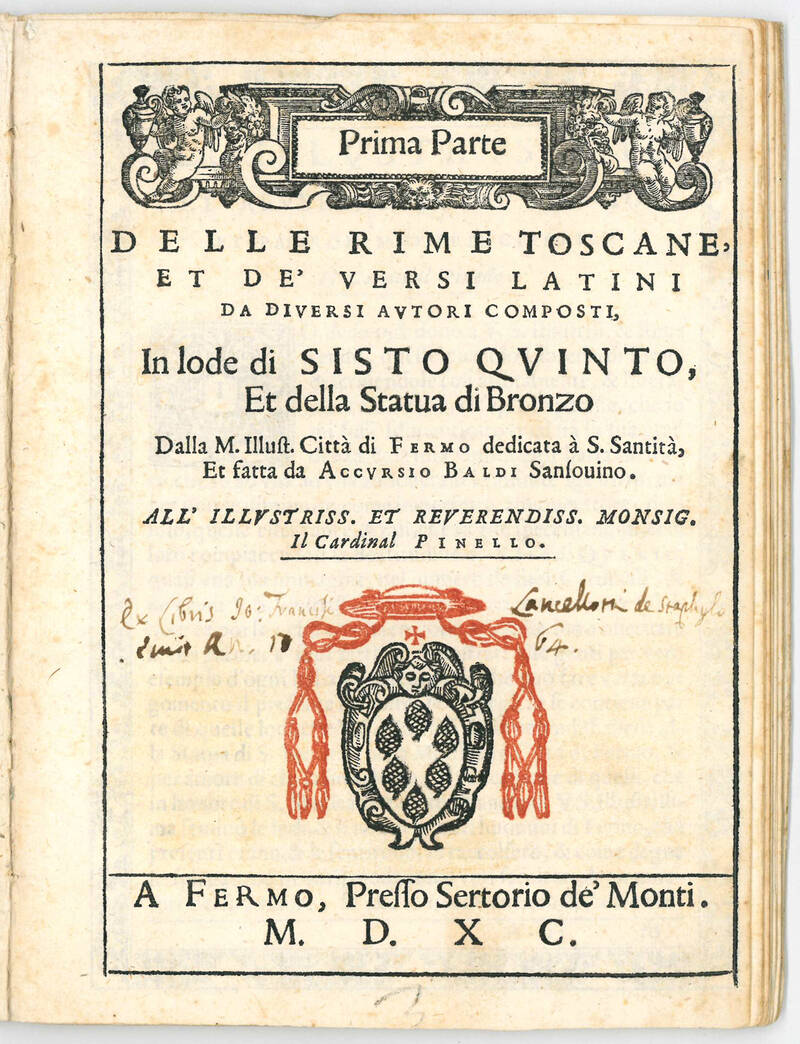Prima parte delle rime toscane, et de' versi latini da diversi autori composti, in lode di Sisto Quinto, et della Statua di Bronzo dalla M. Illust. Città di Fermo dedicata à A. Santità, et fatta da Accursio Baldi Sansovino. All'Illustriss. et Reverendiss. Monsig. il Cardinal Pinello
Autore: BALDI, Accursio called Sansovino (1570-1607)
Tipografo: Sertorio Monti
Dati tipografici: Fermo, 1590
“UT SCULPTURA POESIS” (ROSSI) - NO RECORDED COPY IN US LIBRARIES
4to (195x142 mm). 51, [1] pp. Collation: A-F4 G2. Register and colophon on last leaf verso. First line of the title printed within a woodcut cartouche, title page within a typographic border with the woodcut coat-of-arms of the dedicatee, Cardinal Domenico Pinelli (1541-1611), bishop of Fermo, printed in red and black in the center. Text in italic printed within a woodcut frame throughout. Woodcut decorative initials, head- and tail-pieces. Contemporary boards. On the title page manuscript ownership entry, dated 1764, by Giovanni Francesco Lancellotti from Staffolo near Ancona (1721-1788), a local historian and antiquarian who was the author, among other things, of the Biblioteca picena appeared posthumously at Osimo in 1790-‘96 (cf. G. Schingo, Dizionario Biografico degli Italiani, vol. 63, 2004, s.v.). Outer margin cut short, some occasional light foxing, all in all a good copy.
Rare first edition. On November 13, 1585, Pope Sixtus V, Felice Peretti, a native of the Marche region, founded the University of Fermo, and with the bull of 24 May 1589, united the dioceses of Macerata and Tolentino, Ripatransone, Montalto and San Severino to the archdiocese of Fermo. As a sign of gratitude, the city of Fermo commissioned the sculptor Accursio Baldi called Sansovino a bronze statue of the pontiff to be placed on the facade of the Palazzo dei Priori. The statue, erected in 1590, is still in place today. Other statues were erected around the same time, in Loreto, by Antonio Calcagni, and in Camerino, by Tiburzio Vergelli.
Before working in the Marche, Accursio Baldi, a native of Monte San Savino, Tuscany, had been active in Florence and Siena, initially as an engraver. He produced the illustrations for the volume published to celebrate Francesco de' Medici's marriage to Bianca Cappello in 1579. In 1584, he sculpted the ciborium and two angels for the altar of the Ospedale di Santa Maria della Scala in Siena. He left another sculpture, preserved in Fermo Cathedral, a bust of the jurist Antonio Severo, first professor of law at the newly founded university of Fermo. Baldi was also a goldsmith and a poet; in addition to the poems collected here, five sonnets by him were published in Raffaelle Gualterotti's Rime (Florence, 1581).
Edited by Baldi himself and by him dedicated to Cardinal Pinelli, this collection of Italian and Latin verse, featuring poems by Baldi and others, commemorates the erection of the statue of Sixtus V and celebrates its sculptor, presented in an anonymous piece as a new Myron.
It contains thirty-seven sonnets by various authors: Accursio Baldi (5), to Sixtus V and Torquato Tasso; cavaliere Berdini, to Baldassare Nardi, Giovanni Agostino Costantini (2) and replies (2); cavaliere Giustiniani, Raffaelle Gualterotti (5), cavaliere Martini, and Baldi's reply, Giovan Antonio Nardi (2), Girolamo Pichi (2), Uriel Rosati (4), Bartolomeo Rossi and Baldi's reply, captain Lodovico Savini, and Baldi's reply, Anton Maria Vinco (2), anonymous authors (3); four madrigals by Onorio Guerrieri, an anonymous author (2), and Pier Antonio Chiarenti; a canzone by the same; twelve epigrams by Camillo Schiafinati, ex dominis Villanterii, Ioannis Baptistae Vicecomitis (Giovanni Battista Visconti) (2), Aquilantis Simonetti (Aquileo Simonetti), and anonymous authors (8) (cf. Fondation Barbier-Mueller, online catalogue).
“En 1590, l'amitié entre Gualterotti et Accursio Baldi trouve sa consécration, dans la perspective de l'ut sculptura poesis, dans le recuil de poèmes en l'honneur de la statue en bronze de Sixte V sur son trône, réalisée par Baldi lui-même, à Fermo, de 1588 à 1590 qui fut placée au grand portail du Palais des Prieurs, pour commémorer la foundation du Studio voulu par le Pape. L'opération dirigée par Baldi se proposait évidemment de reproduire le succès d'une initiative éditoriale analogue, prise en 1583 à l'occasion de la mise en place du Ratto della Sabina de Giambologna: un artiste avec lequel Baldi avait été en désaccord à l'occasion d'une commande précédente à Sienne et auquel il voulait probablement s'opposer, fort également d'une habilité littéraire qui faisait défaut à l'artiste flamand” (M. Rossi, Le frontispice du “Polemidoro” de Raffaele Gualterotti (1600), in: “Le livre illustré italien au 16me siècle, Actes du Colloque, Université de la Sorbonne Nouvelle (1994)”, M. Plaisance, ed., Paris, 1999, p. 269).
Edit 16, CNCE31144 (5 recorded copies only, one with an additional leaf containing a sonnet by Barosio Fisolero after G2); A.M. Massinelli, Accursio Baldi e la statua di Sisto V a Fermo, in: “Le Arti nelle Marche al tempo di Sisto V”, Ascoli Piceno, 1992, pp. 232-235.
[12706]







